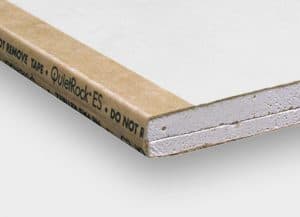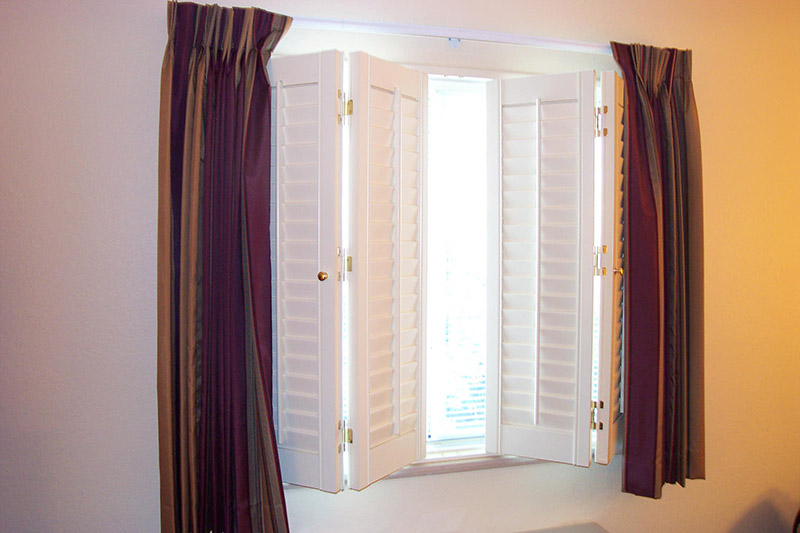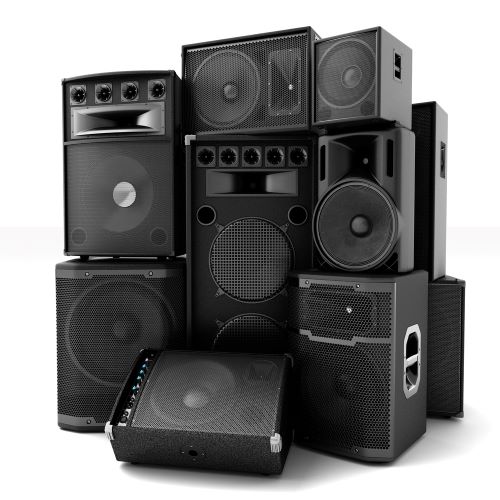Preventing bass sound (this is what you create in your space) and bass noise (made by the neighbor) from passing into the adjoining room is the most difficult soundproofing you will undertake. This article will help you understand what it is, why it is such a problem, and ultimately, how to solve it.
Bass Sounds or Noises
Not only can you hear bass, you can feel it–because low frequencies travel through walls, floors, ceilings, and most anything else–as Structural Noise (Impact Noise). They even travel through concrete and brick.
What Are Bass Frequencies?
Bass sounds are the frequency range between 16 Hertz and 256 Hertz. (Technically, it is also 0 – 20 Hertz but the human ear cannot hear it.) (Wikipedia – Bass) Most adults hear sounds between 20 Hz and 16,000 Hz. There is also a kind of physical component to bass frequencies; so that even deaf people can ‘feel’ the sound.
Note #1: Some definitions of the bass frequency range use 160 Hz as the top end.
Note #2: Hertz (Hz) is defined as one cycle per second. So, a bass note of 100 Hz is 100 cycles per second. More at Wikipedia – Hertz.
Why do Bass Frequencies Penetrate Good Soundproofing?
Sound Transmission Class (STC) testing only considers frequencies between 125 Hz and 4000 Hz. A partition with an STC rating of 65 will provide excellent sound attenuation for most noise (see chart below from Wikipedia – Sound Transmission Class), but because frequencies below 125 Hz have not been factored into the ratings, bass noise may still be an issue.
Sound waves are, essentially, energy that causes air molecules to vibrate. Bass sound waves do not use as much energy as higher frequencies. They also transfer less energy to the air or solid materials (like walls).Therefore, they lose less energy passing through a medium, allowing them to travel farther. High frequency sound waves lose their energy quicker, so heavy materials will block them easier.
Think of your wall as a speaker for bass frequencies that oscillates when sound waves hit one side of it. That oscillation will transfer low frequencies (specially between 70 Hz and 100 Hz) to the other side of the wall–virtually unimpeded.
Here is an illustration of how Sound Transmission Class works.
One pound Mass Loaded Vinyl (MLV) has a ‘stand alone’ STC rating of 26. When added to a standard interior wall with an STC rating of 33 you end up with a 41 rating. Don’t get depressed. STC is a logarithmic scale like the Richter Scale used for earthquakes. For instance, changing the STC from 28 to 38 reduces the noise you hear at 28 by 90% when you increase the STC to 38. For one of the better explanations of STC ratings, and how they work please go to soundproofingmlv.com
Bass Soundproofing Your Space
This is much easier than dealing with noise from the neighbor. Because you are in control of almost everything–sound system, volume, soundproofing, and acoustics. If you own the house, you are also in control of the construction. If it is a rental property, apartment, or condo–maybe not so much.
Previously we have published articles on soundproofing different rooms in your house. In this article I am going to focus on bass sounds. For more general and/or detailed information about room soundproofing, please see some of our other articles–How to Sound Treat a Room, How Much Does it Cost to Soundproof a Room?, and How to Soundproof a Home Theater.
Good soundproofing will cut down on the sound escaping your room. Bass sound requires additional effort.
7 Bass Dampening Options
Bass sounds not only travel through the walls, but also through the floors and ceiling. For truly effective bass sound reduction you will have to soundproof all of them.
1) Seal the Gaps and Cracks
- Rather than include sealing in every section, I am just going to make a couple of blanket statements. All sound is like air. It will flow through any gap or crack in the wall. Bass noise is no different. Even though it can travel through walls, and other framing members, it will move easier through holes in the wall. So, either before you start soundproofing, or during the process when you have access to HVAC and electrical penetrations, use acoustic caulking to seal everything.
- Some examples of everything: electrical boxes and extensions, HVAC pipes specially those penetrating the opposite wall (if any), sill plate to subfloor, any wood framing members with no insulation between them, studs that have shrunk where they meet top plate or sill plate, 1/2″ gap between window and door jambs and the wall framing, cracks in existing drywall, and any other hole, gap, or crack whether you think sound will come through it or not. If you have good access to electrical boxes, putty pads are usually a better choice.
2) Soundproof the Walls
- US Cargo Control sound absorbing blankets. These heavy blankets reduce sound waves passing through the walls because they add both absorption and some mass. I prefer the 80″ x 96″ with grommets on one 80″ side. You can hang them from self-adhesive hooks and they will cover floor to ceiling without having to add extra material. You can use Velcro to join the overlaps (about 6″), and attach them to the baseboard. Unfortunately, they only come black, so you might have to do something creative to lighten up the room (specially if you are doing more than one wall).
- Mass Loaded Vinyl (MLV). MLV is one of the most popular soundproofing materials on the market. Because it works. You can tack it, or glue it, onto the wall and reduce the sound transmission immediately. It is paintable (which is good, because it is also black). You can achieve even better soundproofing by adding sound absorbing blankets or, if you want something more aesthetically pleasing, add 5/8″ soundproofing drywall to get more mass. You can then mud, tape, and paint the drywall.
- Soundproofing drywall and Green Glue. Add 5/8″ soundproofing drywall (such as QuietRock or Certainteed) to the existing wall with Green Glue sandwiched between. The heavy drywall mass will cut down on the bass vibrations that pass through the walls and Green Glue will dampen the sound waves. (Soundproofing drywall like QuietRock and Certainteed have a viscoelastic polymer sandwiched between gypsum panels. The separate layers reduce vibration making it a good product to reduce bass transmission.)
- Sound isolation clips and soundproofing drywall. When it comes to bass soundproofing (and any soundproofing), dead air spaces are your best friend. Using sound isolation clips with hat channel between the existing wall and your new wall will add isolation to mass and dampening. Depending on how much effort you want to expend; you can either install one layer of 5/8″ drywall, or a double layer with Green Glue sandwiched between. Generally, the more you do–the better soundproofing you will achieve. You can find clips and an installation layout at acousticalsolutions.com
- Room within a room. This is the gold standard (or maybe Bitcoin standard in today’s world) of soundproofing. It involves constructing a complete new room inside the existing space that is not connected in any way to walls, or ceiling. It still has to sit on the the floor so you will not get perfect isolation. When properly constructed, the room within a room will satisfy all soundproofing requirements–mass, decoupling, absorption, isolation, and sealing. For more detailed information please see our article How to Build a Room Within a Room.
 QuietRock Soundproofing Drywall
QuietRock Soundproofing Drywall
3) Soundproof the Floor
- Carpet and sound absorbing underlayment. Chances are pretty good that you are not interested in tearing up your floor, so even if you already have carpet in the room, give some consideration to adding another layer c/w 1/2″ RugpadUSA underlayment. If you are going to put in wall-to-wall, you should remove the baseboard, install underlayment and carpet, and re-install the baseboard. If the plan is just to use area-type rugs, you will probably need double sided carpet tape to keep everything in place. Heavy wool rugs work best.
- Jigsaw puzzle sound absorbing exercise mats. BalanceFrom 1″ mats will absorb some of the vibrations your speakers create. They are easy to assemble and you can take them with you if, and when, you leave.
4) Soundproof the Ceiling
- Soundproofing blankets. Yes, you can put blankets up on your ceiling. Use the same US Cargo Control blankets. I would install 1″ x 2″ primed pine every two feet perpendicular to the trusses. (It will save you from using dozens of fasteners to keep the blankets from bagging.) This should also eliminate the need for Velcro to seal the overlaps.
- Soundproofing drywall and isolation clips. What you really need on the ceiling is as much mass and decoupling as possible. It is almost impossible to just add drywall to a textured ceiling–if you want it smooth–and Green Glue is only effective when sandwiched between two solid surfaces. But the isolation clips only need a small section (2″ x 4″ each) scraped down to drywall for each clip. Then add hat channel and attach your soundproofing drywall. Tape, mud, and either paint or texture. For extra mass and sound dampening, add a second layer of drywall with Green Glue sandwiched between.
5) Soundproof the Openings
- Window. Three options you can consider are Nicetown Soundproofing Curtains, AcousticCurtain by Residential Acoustics, (21 – 25 decibel noise reduction), or Shut Eye Shutters by Acoustical Shutters (up to 50 decibel noise reduction). The Nicetown Curtains are hung from a curtain rod and do not lay flat against the wall because of the pleats–allowing noise in and out. AcousticCurtains hang from hooks at the top of the window and roll up out of the way. They can be attached to the wall with Velcro or magnets supplied by the manufacturer. Shut Eye Shutters usually fit inside the window frame or on the wall. Both products are available in many colors, and are custom made to fit your measurements.
- Door. I would recommend the same 3 options for the door. The only difference is that Residential Acoustics calls their door product AcoustiDoor. Same product, same noise reduction, same options. In addition, make sure you weatherstrip the door frame, and add a sweep to the bottom. You can also glue Mass Loaded Vinyl, or a sheet of 3/4″ MDF, to the inside of the door. If possible, replace the door slab with a solid core, or solid wood, unit. Please see our article How to Soundproof a Bathroom Door for more details.

6) Bass Absorbing Products
- Bass Traps. If you are making the sound, add bass traps to all 8 corners of the room to absorb as much of the bass frequencies as possible. For some reason bass sound waves ‘gather’ in the corners. Please see our article How to Sound Treat a Room.
- More Bass Traps. Use Pyle Sound Dampening Speaker foam pads under any, and all sound producing equipment–specially anything producing bass frequencies. Not only do they get rid of the vibration, they also absorb bass sound waves.
7) Furniture Placement
If you have an heavy furniture or book cases in the room, make sure you place them against the walls you most want to soundproof. Even if you have already added drywall mass to the wall; the more mass, the better. It all blocks and/or absorbs bass sound waves.
Bass Soundproofing Your Neighbor
This is a much tougher job because you do not control that space, music system, or personality; therefore limiting your options. In addition to using some of the soundproofing suggestions above, here are a few more.
4 Bass Dampening Options for Incoming
1) Re-arrange Your Room
- Place heaviest furniture against sound-producing wall. Also bookcases, if available. Place the head of your bed (if the room is a bedroom) as far from the noise as possible.
- Isolate your furniture. BXI Anti-Vibration Isolation Pads are a 2″ thick cork/rubber composite that will support over 400 pounds (sizes are 2″ x 2″ or 6″ x 6″). Set all of your furniture, including bed on these to eliminate–or at least reduce–vibrations coming through the floor.
2) Soundproof Walls, Floor, Ceiling, Openings
Any, or all, of the techniques, products, and suggestions mentioned in the previous section will be helpful when trying to bass soundproof your neighbor–except bass absorbing product. How much time, effort, and money you want to put into it depends on whether, or not, you own your home. If you are renting, or have to deal with the condo board from hell, you might not want to, or be able to, invest very much into the project–like building a room within a room.
If you do not want to spend a lot, soundproof blankets, extra carpet with thick underlayment, exercise mats, window and door curtains recommended above might be enough to provide some of the peace you want.
3) Use Technology
- White Noise Machines. These machines produce sounds that cancel out some of the incoming noise. Unfortunately, they will have no effect on the vibrations. Place the machine on your desk or night stand for the best results. (Note: The reviews for a lot of the available machines seem to be all over the place which may be because of the type of sleeper, or the type of noise.)
- Ear plugs/headphones. If you can live with the annoyance of either of these products, they are an option to cut down bass noise and allow you a little peace in your own home. (I would be probably be more than a little upset by this situation.)
4) Talk to Your Neighbor
I am not about to give you a script. I do not know you, your neighbor, or the situation–except that if it is annoying enough for you to be reading this, you probably need to do something about it. But I will make a few suggestions:
- Do not see them when the noise is mind numbing.
- Do not talk to them when you are any of: drunk, stoned, pissed off.
- Do not talk to them naked. Unless you are a super model. It will not help. (Yes, I know that is probably sexist.)
- Do suggest they turn on the noise maker to the volume they prefer, and invite them into your place.
- Get the condo board/caretaker/landlord involved only as a last resort.
- You probably cannot use a baseball bat to fine tune her/his sub-woofer. Or anything else, for that matter.
Note: It is also probably not wise to set up your own gazillion watt speakers pointed at the neighbor. Sound wars between dueling loons is never pretty.
5) Bass Absorbing Products
Unfortunately, bass traps only work for noise produced in a room. They will do nothing for incoming noise. Any acoustic treatments you are using in the room will also have virtually no effect on any bass frequencies that pass into the room from next door, above, below, or outside. If you are talking to your neighbor, offering to buy and install bass traps in his place may be an option you can explore. If you can get she/he to go for it, your bass noise level will certainly decrease.
End Notes
One final option is to move out–either them or you. Once again, you can only control your actions. If you have truly exhausted all other options at your disposal; this is probably the last resort, but it may be the only viable choice.


Hi Terry,
I’d love to speak with you about soundproofing our 3rd floor residential units. We have a cocktail lounge on the second floor. Happy to jump on a call if convenient for you.
I look forward to speaking with you on the best methods that will prevent sound from traveling up to the 3rd floor from below.
Best,
Chris
919-536-8898
Christopher,
Another couple of articles that may give you some help:
How to Build a Soundproof Room-Within-a-Room
15 Ways of Soundproofing Interior Walls Without Removing Drywall
Terry